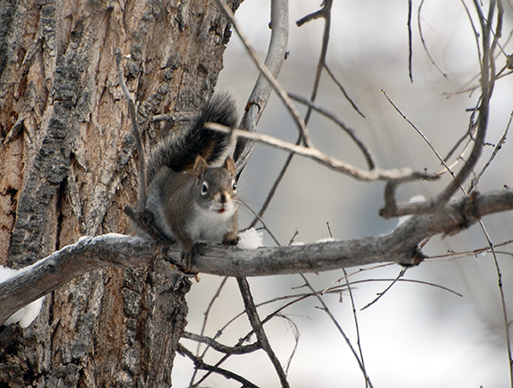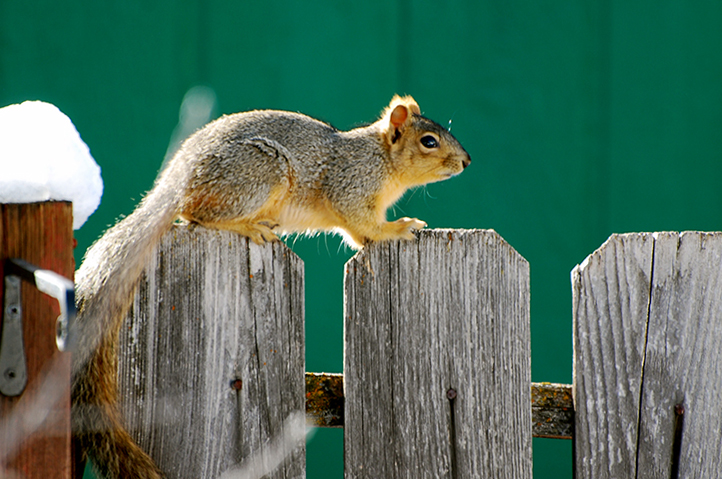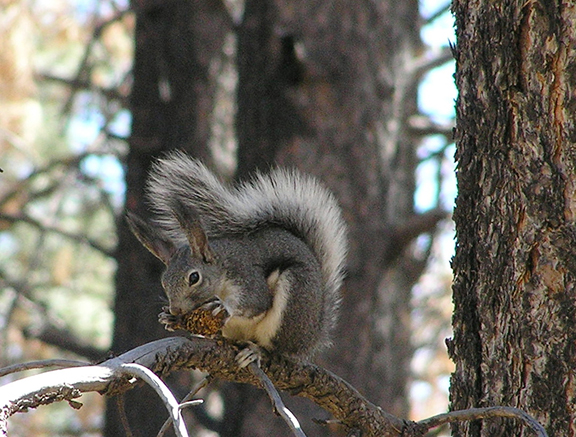A tiny squirrel helps shape the forest

A pine squirrel on alert. OST photo
Fresh snow muffles my footsteps on the less-traveled paths of Smuggler Mountain Open Space. It’s a place of quiet winter reverie. That is, until the silence is shattered by a burst of staccato chatter that could, as they say, wake the dead.
A pine squirrel is objecting to my presence and all of the forest knows it. This territorial watchdog of the woods unleashes a furious scolding that continues, unabated, long after I’m out of sight. My transgression? Simply being there.
No 9-ounce woodland creature makes a more recognizable racket than the pine squirrel (Tamiasciurus hudsonicus), also known as the American red squirrel or chickaree. In Pitkin County and the Roaring Fork Valley, it is the only native species of tree squirrel one will encounter. Locally, its color varies broadly from reddish-brown to mostly gray in winter, with a noticeable white ring around each eye.
Colorado is home to just three species of tree squirrels (not to be confused with ground squirrels, such as chipmunks). They are the pine squirrel, fox squirrel and Abert’s squirrel. Abert’s (Sciurus aberti) is a native species, but isn’t found locally. They are generally a striking black in color, or grey with light underparts, and sport magnificent, tufted ears. The species is dependent on mature Ponderosa pine forests for its life cycle and can be found in areas of Colorado’s Front Range, including Rocky Mountain National Park. While the upper Crystal River Valley boasts some imposing Ponderosas, it lacks the density of the big trees necessary to support Abert’s squirrels.
Then there’s the fox squirrel, easily recognizable by its large size and orange to buff coloring. It’s the largest species of tree squirrel native to North America. A common urban dweller in these parts, fox squirrels are the ones raiding backyard birdfeeders and playfully driving dogs to distraction as they skitter along fences and dash around tree trunks. The fox squirrel is not native to Colorado, nor is it considered an invasive species, because it expanded its range on its own. Fox squirrels made their way here from the eastern United States, following tree-lined river corridors and hopscotching West as humans settled native prairies and created urban forests.
Fox squirrels prefer areas where trees are widely spaced and the understory is open, leaving the irritable pine squirrel in charge of the deep woods. From late summer through fall, pine squirrels energetically clip pine cones from trees, bombarding the forest floor with hundreds of cones per hour, according to one source.
The cones are cached in middens – mounds of eaten and uneaten cones and discarded scales – to be consumed throughout the winter and hoarded for lean years. The middens, found at the base of pine trees, may grow to more than a foot in depth over years of use. Pine squirrels can eat up to two-thirds of the pine seeds produced annually in a forest, though fungi are also a key component of their diet, particularly in summer and autumn.
The literature regarding how many pine cones a pine squirrel consumes (really, it just eats the seeds) varies, but one calculation estimated a range of 50 to 156 cones per day, and suggested a single squirrel could stash tens of thousands of cones in a good year.
The pine squirrel’s reliance on pine seeds can literally shape an ecosystem. A 2005 conservation assessment of the pine squirrel for the U.S. Forest Service’s Rocky Mountain Region noted these tiny mammals are believed to have influenced the evolution of conifers and conifer-dominated ecosystems across North America.
That was certainly the case at Yellowstone National Park, where researchers concluded that pine squirrels had an impact on the recovery of lodgepole pine stands after 1988 wildfires in the park. In some areas, the squirrels had consumed most of the serotinous pine cones (the cones that remain tightly closed until they are opened by fire), resulting in a patchy recovery of lodgepoles. As tree densities changed, so did the ecosystem. Different plants filled in the sunny openings where lodgepoles once stood, providing habitat for insects, birds and other animals that don’t dwell in a forest of heavy timber, but displacing the ones that do.
On average, it took about one pine squirrel per football field-sized swath of forest to dramatically change rates of serotiny (the process of trees storing seeds until they’re released by fire) and, as a result, forest regeneration, according to a research team that included Craig W. Benkman, a now-retired University of Wyoming professor.
“It’s a stunning result,” Benkman said in a telephone conversation. “People talk about wolves in Yellowstone having an impact, but squirrels do too – a very pervasive impact.”
In 2014, Benkman wrote about the findings in a blog, “A small mammal with an outsized impact.”
“In short, he concluded, “a small squirrel has an evolutionary impact with outsized ecological consequences.”
Now that’s something to chatter about.
– By Janet Urquhart, Pitkin County Open Space and Trails

A fox squirrel. OST photo

Abert’s squirrel (U.S. Forest Service)

A serotinous pine cone can be opened by the heat of fire, and by a pine squirrel. OST photo
